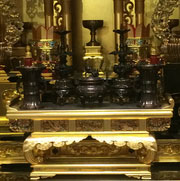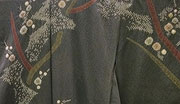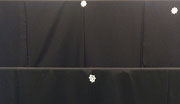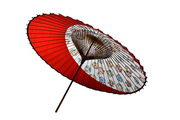Tochigi and more
- Sort by
- Popularity
- Name
-
Mashiko ware Mashiko yaki
- Ceramic
- Tochigi

Mashiko ware (called Mashiko yaki in Japanese) is produced in the area around the town of Mashiko in Tochigi prefecture. The clay used in Mashiko ware is rich in silicic acid and iron with a high plasticity, making it easy to shape and highly fire…
View more
-
Mino ware Mino yaki
- Ceramic
- Gifu

Mino ware (called Mino yaki in Japanese) is a ceramic ware produced in the Tono area of Gifu prefecture. It has a long history and tradition but has adapted to modern life style. A notable feature of Mino ware is its wide variety of pottery. Mino …
View more
-
Nishijin brocade Nishijin ori
- Woven textiles
- Kyoto

Nishijin brocade (called Nishijin ori in Japanese) is woven silk produced in the northwestern part of Kyoto. Kamigyo ward and Kita ward cover this area of Kyoto today, but this area is called Nishijin. According to official rules, only the brocade…
View more
-
Kyo textiles Kyo yuzen
- Dyed textiles
- Kyoto

Kyo textiles are dyed textiles made throughout Kyoto prefecture that feature a wide range of vivid colors and a technique of pictorial designs of animals, nature and daily items called yuzenmoyo. The dyeing method is very unique as artisans put gl…
View more
-
Mino traditional Japanese paper Mino washi
- Traditional Japanese paper
- Gifu

Mino washi is a type of Japanese paper made in Gifu prefecture. Washi is made from paper mulberry which is a plant that grows in the city of Mino, a place of abundant forests. Ancient manuscripts in the Shosoin Repository* indicate the history of …
View more
-
Kyo folding fans Kyo sensu
- Other crafts
- Kyoto

Kyo folding fans (called Kyo sensu in Japanese with sensu meaning folding fan) are mainly produced in Kyoto. From ancient times they have been valued as high quality art works because of their beautiful designs with gold or silver leaves or gold l…
View more
-
Marugame uchiwa fans Marugame uchiwa
- Other crafts
- Kagawa

Marugame uchiwa are a type of fan made in the area around the city of Marugame, Kagawa prefecture. It is believed that, in the early Edo period (1603-1868), the first Marugame uchiwa were made as souvenirs for pilgrims to the Konpira Shrine. The o…
View more
-
Gifu lanterns Gifu chochin
- Other crafts
- Gifu

Gifu lanterns (called Gifu chochin in Japanese) are produced in the city of Gifu, Gifu prefecture and have a history of over three hundred years. In 1995, their high level of craftsmanship was recognized with a designation as a National Traditiona…
View more
-
Kagawa lacquerware Kagawa shikki
- Lacquerware
- Kagawa

Kagawa lacquerware (called Kagawa shikki in Japanese) is produced in the area around the city of Takamatsu, Kagawa prefecture. There is a wide range of products, such as cake boxes, trays, low tables, and display cases, which are widely popular fo…
View more
-
Kyo doll Kyo ningyo
- Dolls, kokeshi
- Kyoto

Kyo dolls (called Kyo ningyo in Japanese) are produced in the city of Kyoto and its surrounding areas in Kyoto prefecture. They are made by several different artisans with their specialized expertise. There are doll head artisans as well as those …
View more
-
Ichii woodcarvings Ichii itto bori
- Wood, bamboo crafts
- Gifu

Ichii woodcarvings (called Ichii itto bori in Japanese) are produced in the Hida region of Gifu prefecture, and made only from the wood of ichii (Japanese yew), the prefectural tree of Gifu. The ichii tree gets its name from a scepter made of Japa…
View more
-
Kyo uchiwa fans Kyo uchiwa
- Other crafts
- Kyoto

Kyo uchiwa are a type of fan made in Kyoto prefecture. From the many types of Japanese traditional fans, there are three broad categories: Chinese-inspired, southern-inspired, and Korean-inspired with this craft coming from the third category. Th…
View more
-
Hida-shunkei lacquerware Hida shunkei
- Lacquerware
- Gifu

Hida-shunkei lacquerware is produced around the city of Takayama in Gifu prefecture. The name is said to come from the fact that the articles produced initially had a similar coloring to Hishunkei tea containers. This craft is notable for having …
View more
-
Kiryu brocade Kiryu ori
- Woven textiles
- Gunma

Kiryu brocade (called Kiryu ori in Japanese) is a woven cloth produced in the city of Kiryu, Gunma prefecture. This area has a lush environment with excellent climate and terrain, helping it to be prosperous in the silk industry for years. Kiryu i…
View more
-
Kyo ware/Kiyomizu ware Kyo yaki Kiyomizu yaki
- Ceramic
- Kyoto

Kyo-ware/Kiyomizu-ware (called Kyo yaki/Kiyomizu yaki in Japanese) is a type of pottery produced in the Kyoto area. Originally, Kyo-ware was a general term for all pottery produced in Kyoto, while Kiyomizu-ware specifically referred to pottery pro…
View more
-
Kyo laquerware Kyo shikki
- Lacquerware
- Kyoto

Kyo lacquerware (called Kyo shikki in Japanese) is produced in the Kyoto area. Since it developed at the same time as the tea ceremony culture, this craft possesses a wabi-sabi* quality. Kyo lacquerware has a thinner and more delicate wood grain t…
View more
-
Kyo braided cords Kyo kumihimo
- Other textiles
- Kyoto

Kyo Braided Cords (called Kyo Kumihimo in Japanese) are produced around the cities of Kyoto and Uji, Kyoto prefecture. Since the Heian period (794-1192), this craft has been found on prestigious and sacred pieces such as Buddhist and Shinto altar …
View more
-
Kyo wood joinery Kyo sashimono
- Wood, bamboo crafts
- Kyoto

Kyo Sashimono is a kind of wood joinery produced in the prefecture of Kyoto. Sashimono is a collective name for furniture and furnishings assembled with wood joints that originates from the process of measuring with a monosashi or woodwork ruler. …
View more
-
Kyo-komon textiles Kyo komon
- Dyed textiles
- Kyoto

Kyo Komon are fine-patterned textiles produced in Kyoto prefecture. Kyoto, a historical center of dyed textiles, is renowned for its superb fabrics resulting from exceptional dyeing and stencil making. This craft has beautifully elegant colored pa…
View more
-
Isesaki traditional resist-dyed textiles Isesaki kasuri
- Woven textiles
- Gunma

Isesaki Kasuri is a type of woven fabric produced in Isesaki, Gunma prefecture. Mainly used for kimono, this fabric has been admired for its texture since ancient times. Today, neckties and shop curtains called noren in Japanese are also produced.…
View more
-
Kyo Buddhist altar Kyo butsudan
- Household Buddhist altars
- Kyoto

Kyo Buddhist Altars (called Kyo Butsudan in Japanese) are produced in the cities of Kyoto and Kameoka in Kyoto. Most Kyo Buddhist Altars are made for temples instead of households. They are professionally handcrafted by a number of respective expe…
View more
-
Kyo embroidery Kyo nui
- Other textiles
- Kyoto

Kyo Embroidery (called Kyo-nui) is produced in Kyoto, Kyoto prefecture. This graceful craft reflects the elegance of Kyoto's culture and requires meticulous skill. Artisans of this craft pursue absolute perfection and freely use costly silk, …
View more
-
Nibutani carved wooden tray Nibutani ita
- Wood, bamboo crafts
- Hokkaido

Nibutani Carved Wooden Trays (called Nibutani ita in Japanese) are produced in Biratori, Hokkaido. The origin of the town name, is an Ainu language word for cliff, pirauturu. This craft is known for its patterns like a spiral pattern called moreun…
View more
-
Kyo art preservation Kyo hyogu
- Other crafts
- Kyoto

Kyoto Art Mountings, called Kyo Hyogu in Japanese,are mountings done in Kyoto prefecture. Hyogu or hyoso is a traditional technique to strengthen and preserve calligraphy works, paintings and the like with paper or cloth and adding decorations to …
View more
-
Nibutani bark cloth Nibutani attoushi
- Woven textiles
- Hokkaido

Nibutani Bark Cloth (called Nibutani-attushi in Japanese) is a bark fiber fabric produced in the region surrounding the the town of Biratori, Hokkaido. The term Nibutani originates from niputai which is an Ainu (indigenous people of north Japan) l…
View more
-
Kyo Buddhist altar equipment Kyo butsugu
- Household Buddhist altars
- Kyoto

Kyo Butsugu are Buddhist altars and altar fittings made in Kyoto. Studded with temples of various sects, Kyoto has always prospered as the center of Buddhism, inevitably leading to increasing demand for altar fittings for memorial services. 80% of…
View more
-
Kyo dyed textiles Kyo kanoko shibori
- Dyed textiles
- Kyoto

Kyo Kanoko Shibori is a dyed textile produced in Kyoto Prefecture. Shibori is one of the tie-dye techniques that create patterns by tying the textile before dyeing so that the tied parts remain white. This particular Shibori resembles fawn spots a…
View more
-
Kyo-ishi craft Kyo ishi kogeihin
- Stonework
- Kyoto

Kyo-ishi Craft called Kyo-ishi Kougeihin in Japanese, are stonework and gem carvings produced in and around the cities of Kyoto and Uji, in the Kyoto prefecture. Abounding in quality granite from the village of Kitashirakawa at the foot of Mt. Hi…
View more
-
Kyo kimono-dyeing Kyo kuromontsuki zome
- Dyed textiles
- Kyoto

Kyo Kuromontsuki Zome is a dyed fabric produced in the areas including Kyoto city and Kameoka city in Kyoto prefecture. The characteristic of Kyo Kuromontsuki Zome is its high quality and graceful black color. The kimonos that are worn for funeral…
View more
-
Gifu Japanese Umbrellas Gifu Wagasa
- Other crafts
- Gifu

Japanese umbrellas are not only used on rainy days or as parasols, but there are also umbrellas used for dancing and larger parasols called nodategasa used for outdoor tea ceremonies. They become very slim and delicate when they are closed, and t…
View more
- 1































































































































































































































































































